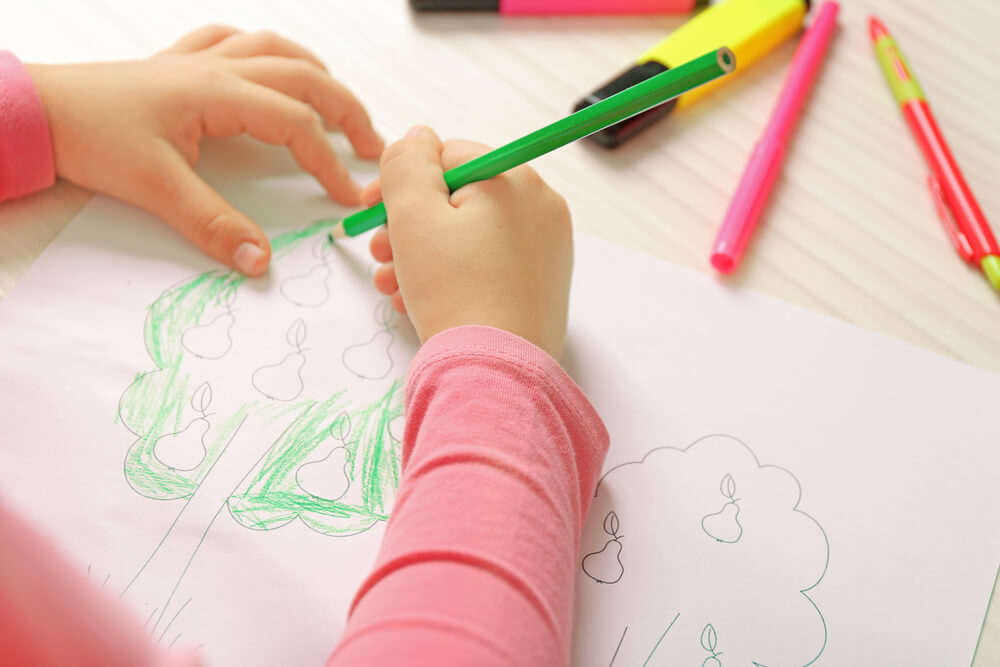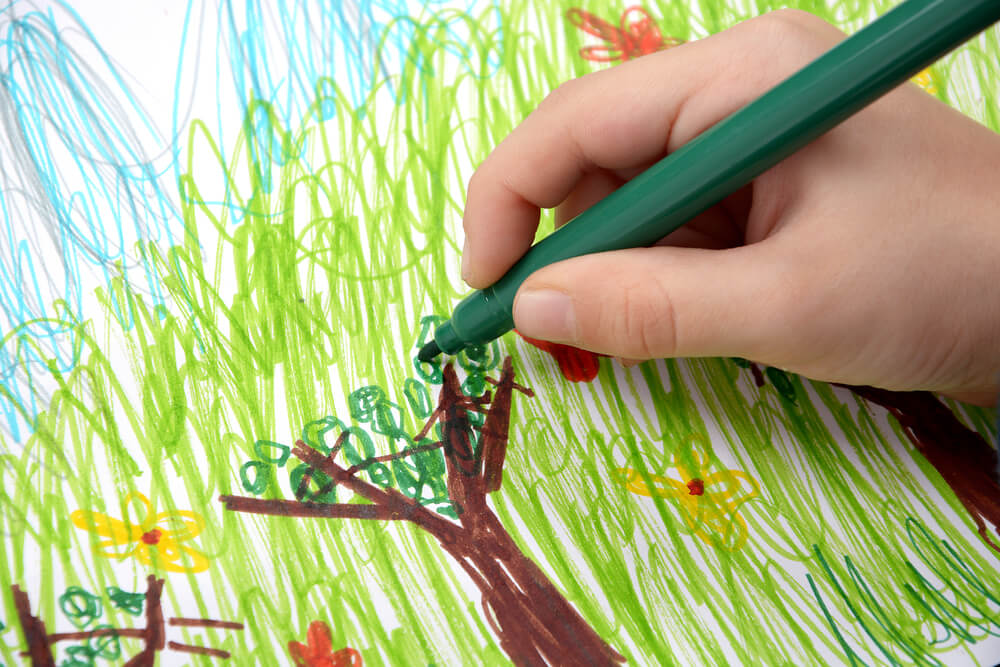Tree Test: Discover Your Child's Personality Through Their Drawings

Have you ever heard of the tree test? It’s a drawing activity that can help you discover your child’s personality. Keep reading!
As children grow up, their drawings become a vital tool for their development, as they allow them to increase their creativity and master their motor skills.
Apart from that, they’re a didactic resource that gives them a sense of well-being, calms them down, clears their minds, and entertains them for a long time.
In the same way, drawing allows children to detect some of their abilities. It also helps them to enhance coordination and improve brain activity, as it promotes the establishment of new neuronal connections.
In addition to all this, drawing is also a tool through which children communicate. Through their creations, infants can express their thoughts and the aspects of their environment that most attract their attention.
Because of this, this activity has become an extremely useful technique for identifying children’s personalities. That’s because, in drawings, little ones recreate with sincerity the way they perceive their reality.
Read more: Personality Development in Childhood
The tree test
Due to the implications of drawing, psychology promoted a strategy to use it to analyze children’s behavioral traits. This technique consists of having them draw a tree just as it comes to their mind.
Experts indicate that it’s best to apply the tree test to children from 5 years of age because, at that age, they already have a good command of their motor skills.
To make a tree, you don’t have to be an expert, and you should make it clear to your child that they have total freedom to make the creation any way they wish.

This is how you achieve their sincerity because you convey to them that whatever they decide will be okay.
How to interpret it?
Psychologists have determined that each part of a tree reveals important information. For this reason, they’ve set some parameters to clarify the personality traits that children show in their drawings.
The ground
First of all, psychologists establish that if the child doesn’t draw the ground, this communicates that they’re still insecure. This is because it shows that, for them, all elements are floating or wandering and that they don’t have their own space.
On the contrary, if the child draws the ground, this shows that they’re self-confident because they make it clear that all elements can have stability.

What the tree’s roots say about your child’s personality
Regarding the roots, specialists establish that the omission of these details reveals that the child feels fear. They don’t find in their daily life elements that make them feel supported.
In contrast, when the roots are drawn, we can interpret that the child has good management of their emotions and that, at any time, they can attach themself to the factors that produce well-being.
The trunk, one of the most relevant aspects of the tree test
If the trunk is drawn in a thin and irregular way, it means that the child has fears and insecurities and that instability is always present in their life.
On the other hand, when a firm trunk is drawn, this indicates that the child is strong, as it implies that they have the strength to remain rooted despite adverse circumstances.
The leaves
As for the leaves, when they’re recreated with a small size, they show a high degree of shyness and that the child isn’t willing to highlight their details.
Finally, when they’re drawn with a larger size and some fruits, we can infer that the child is confident and that they relate well with others. Also, it shows that they’re willing to highlight their characteristics and that they’re aware that they possess qualities that are beneficial to others.

You may be interested in: Parenting Styles and Children’s Personalities
What you should keep in mind regarding the tree test
Although the tree test reveals important behavioral factors, it doesn’t reliably determine what your child’s personality is like. For this reason, when parents suspect that their child may have an emotional problem, it’s vital to seek professional advice to make the necessary evaluations. Similarly, the test should always be analyzed by a specialist.
Have you ever heard of the tree test? It’s a drawing activity that can help you discover your child’s personality. Keep reading!
As children grow up, their drawings become a vital tool for their development, as they allow them to increase their creativity and master their motor skills.
Apart from that, they’re a didactic resource that gives them a sense of well-being, calms them down, clears their minds, and entertains them for a long time.
In the same way, drawing allows children to detect some of their abilities. It also helps them to enhance coordination and improve brain activity, as it promotes the establishment of new neuronal connections.
In addition to all this, drawing is also a tool through which children communicate. Through their creations, infants can express their thoughts and the aspects of their environment that most attract their attention.
Because of this, this activity has become an extremely useful technique for identifying children’s personalities. That’s because, in drawings, little ones recreate with sincerity the way they perceive their reality.
Read more: Personality Development in Childhood
The tree test
Due to the implications of drawing, psychology promoted a strategy to use it to analyze children’s behavioral traits. This technique consists of having them draw a tree just as it comes to their mind.
Experts indicate that it’s best to apply the tree test to children from 5 years of age because, at that age, they already have a good command of their motor skills.
To make a tree, you don’t have to be an expert, and you should make it clear to your child that they have total freedom to make the creation any way they wish.

This is how you achieve their sincerity because you convey to them that whatever they decide will be okay.
How to interpret it?
Psychologists have determined that each part of a tree reveals important information. For this reason, they’ve set some parameters to clarify the personality traits that children show in their drawings.
The ground
First of all, psychologists establish that if the child doesn’t draw the ground, this communicates that they’re still insecure. This is because it shows that, for them, all elements are floating or wandering and that they don’t have their own space.
On the contrary, if the child draws the ground, this shows that they’re self-confident because they make it clear that all elements can have stability.

What the tree’s roots say about your child’s personality
Regarding the roots, specialists establish that the omission of these details reveals that the child feels fear. They don’t find in their daily life elements that make them feel supported.
In contrast, when the roots are drawn, we can interpret that the child has good management of their emotions and that, at any time, they can attach themself to the factors that produce well-being.
The trunk, one of the most relevant aspects of the tree test
If the trunk is drawn in a thin and irregular way, it means that the child has fears and insecurities and that instability is always present in their life.
On the other hand, when a firm trunk is drawn, this indicates that the child is strong, as it implies that they have the strength to remain rooted despite adverse circumstances.
The leaves
As for the leaves, when they’re recreated with a small size, they show a high degree of shyness and that the child isn’t willing to highlight their details.
Finally, when they’re drawn with a larger size and some fruits, we can infer that the child is confident and that they relate well with others. Also, it shows that they’re willing to highlight their characteristics and that they’re aware that they possess qualities that are beneficial to others.

You may be interested in: Parenting Styles and Children’s Personalities
What you should keep in mind regarding the tree test
Although the tree test reveals important behavioral factors, it doesn’t reliably determine what your child’s personality is like. For this reason, when parents suspect that their child may have an emotional problem, it’s vital to seek professional advice to make the necessary evaluations. Similarly, the test should always be analyzed by a specialist.
All cited sources were thoroughly reviewed by our team to ensure their quality, reliability, currency, and validity. The bibliography of this article was considered reliable and of academic or scientific accuracy.
- Montejo E. La timidez en los niños, un factor que dificulta el aprendizaje escolar [Internet]. México: Universidad Pedagógica Nacional; 2005. [citado 03 de enero de 2022].
This text is provided for informational purposes only and does not replace consultation with a professional. If in doubt, consult your specialist.








